International Steel Prices

Foreign vs. Domestic Hot Rolled Steel: Prices Rising Globally
Written by Brett Linton
March 24, 2022
Steel prices around the globe continue to surge in response to the war in Ukraine, and the brief competitive advantage domestic prices held over foreign steel in early-March has faded, according to SMU’s latest foreign versus domestic hot rolled steel price comparison. Select foreign HRC prices range anywhere from $267 per ton cheaper than domestic prices to $88 per ton more expensive, after taking freight costs, trader margins and tariffs into consideration.
The following calculation is used by Steel Market Update to identify the theoretical spread between foreign hot rolled steel prices (delivered to U.S. ports) and domestic hot rolled coil prices (FOB domestic mills). This is only a “theoretical” calculation as freight costs, trader margins, and other costs can fluctuate, ultimately influencing the true market spread. This compares the SMU U.S. hot rolled weekly index to CRU hot rolled weekly indices for Germany, Italy and Far East Asian ports.
![]()
In consideration of freight costs, handling, trader margin, etc., we add $90 per ton to all foreign prices to provide an approximate “CIF U.S. ports price” that can be compared against the SMU U.S. hot rolled price. Recent spot checks show freight on SE Asian imports into Houston costing between $100-110 per ton and costs on European products between $85-90 per ton. Buyers should use our $90 rate as a benchmark and adjust up or down to their own shipping and handling costs if necessary.
Note that effective Jan. 1, 2022, the traditional Section 232 tariff no longer applies to most imports from the European Union, it has been replaced by a tariff rate quota (TRQ). Therefore, the German and Italian price comparisons in this analysis no longer include a 25% tariff, and comparisons to prior prices may be skewed. SMU still includes the 25% S232 tariff on foreign prices from other countries. We do not include any antidumping (AD) or countervailing duties (CVD) in this analysis.
Far East Asian HRC (East and Southeast Ports)
As of Wednesday, March 23, the CRU Far East Asian HRC price rose $9 week over week at $835 per net ton ($920 per metric ton), up $68 from one month prior. Adding a 25% tariff and $90 in estimated import costs, the delivered price of Far East Asian HRC to the U.S. is $1,133 per ton. The latest SMU hot rolled price average is $1,400 per ton, up $140 from one week prior, and up $380 from one month ago. Therefore, U.S.-produced HRC theoretically is now $267 per ton more expensive than imported Far East Asian HRC; that differential was $138 per ton last week, yet we saw the opposite two weeks prior when domestic prices were $72 per ton cheaper. One month ago, domestic HRC was $28 per ton cheaper than Far East Asian prices. The largest price spread between these regions was $847 in September 2021, when Far East Asian prices held a considerable advantage.
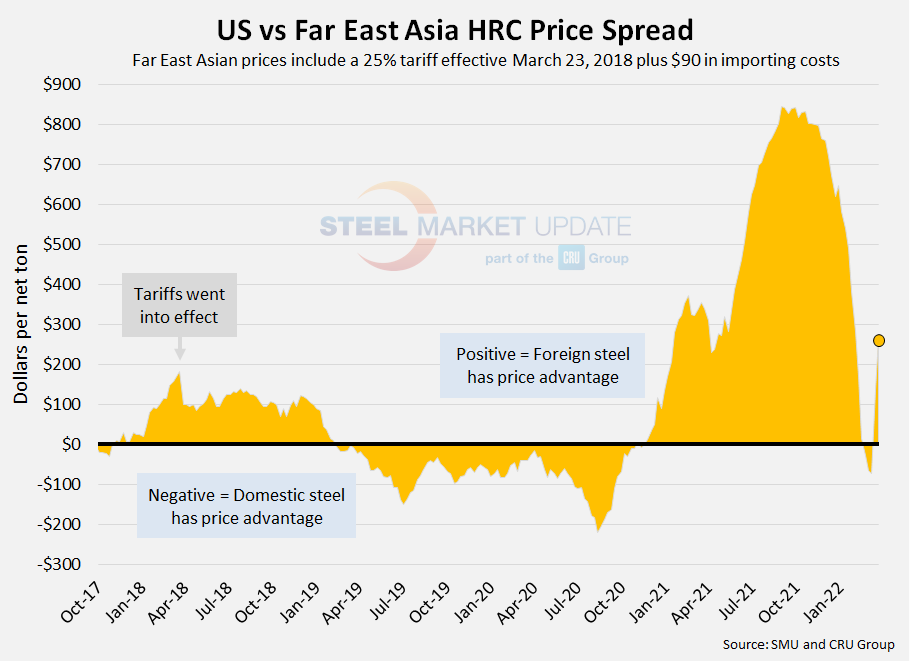
Italian HRC
CRU published Italian HRC prices at $1,295 per net ton ($1,428 per metric ton), up $121 from last week, and up $367 from one month ago. After adding import costs, the delivered price of Italian HRC is approximately $1,385 per ton. Accordingly, domestic HRC is now theoretically $15 per ton more expensive than imported Italian HRC, compared to one week prior when we saw potential domestic savings of $4. One month ago imported Italian HRC offered a theoretical savings of $2 per ton. Prior to removal of the 25% tariff, the early-November spread of $577 per ton was the largest seen in SMU’s limited data history.
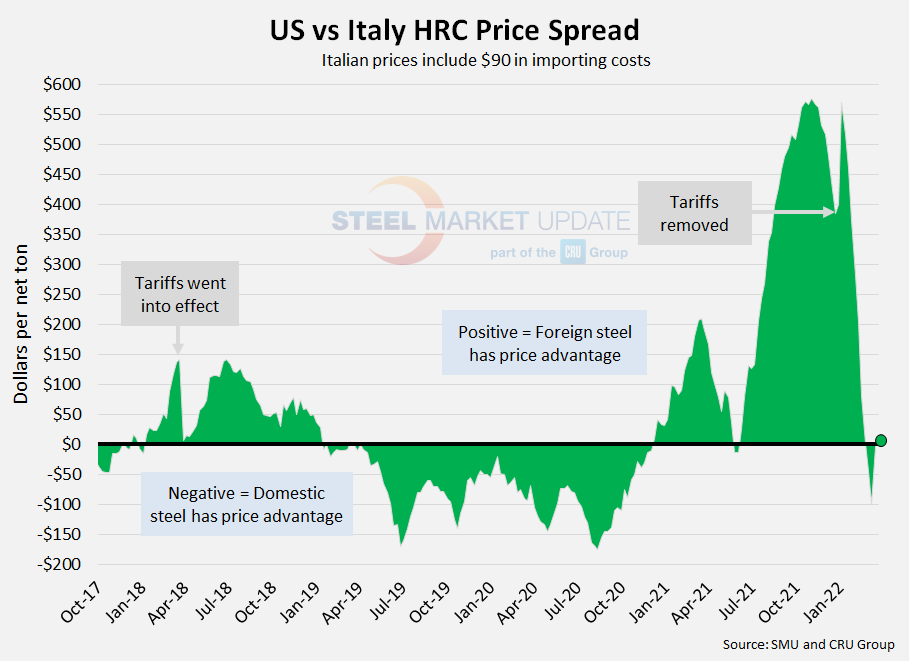
German HRC
The latest CRU German HRC price is $1,398 per net ton ($1,541 per metric ton), up $154 from last week, and up $418 from one month ago. After adding import costs, the delivered price of German HRC is approximately $1,488 per ton. Accordingly, domestic HRC is theoretically $88 per ton cheaper than imported German HRC, up from $74 last week. This is the fifth consecutive week domestic steel prices have held this price advantage. One month ago, German prices were $50 per ton more expensive than domestic steel. Prior to removal of the 25% tariff, the mid-October spread of $504 per ton was the largest seen in SMU’s limited data history.
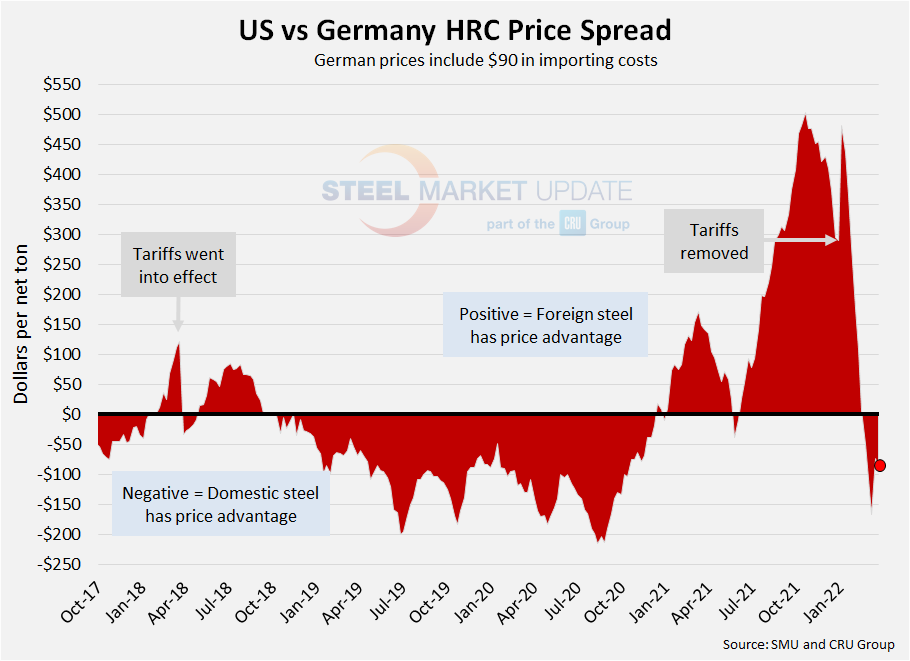
The graph below compares all four price indices and highlights the effective date of the tariffs. Foreign prices are referred to as “equalized,” meaning they have been adjusted to include importing costs (and tariffs in some cases) for a like-for-like comparison against the U.S. price. The second graphic shows the same data yet focuses on prices over the last 18 months.
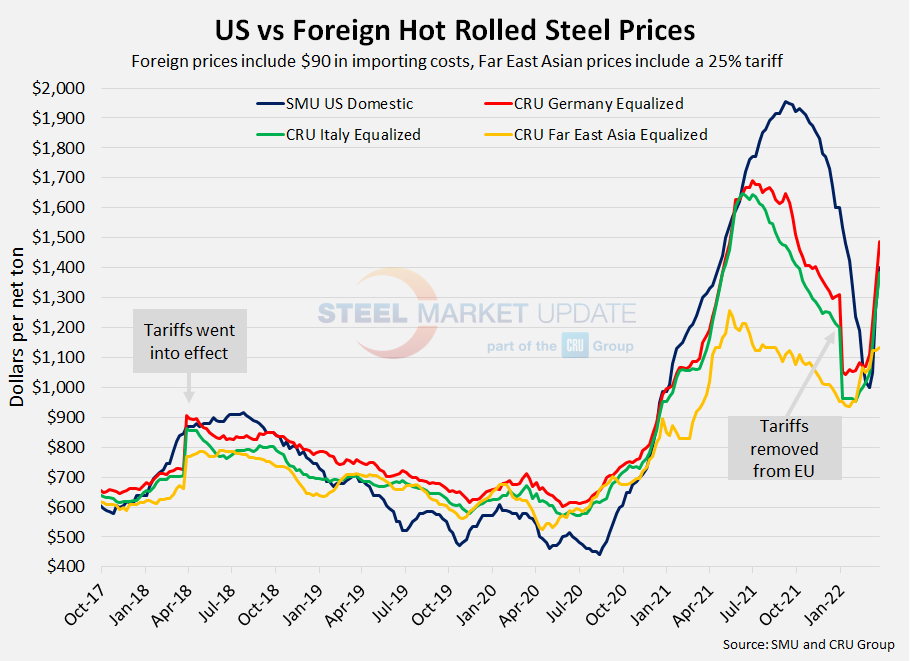
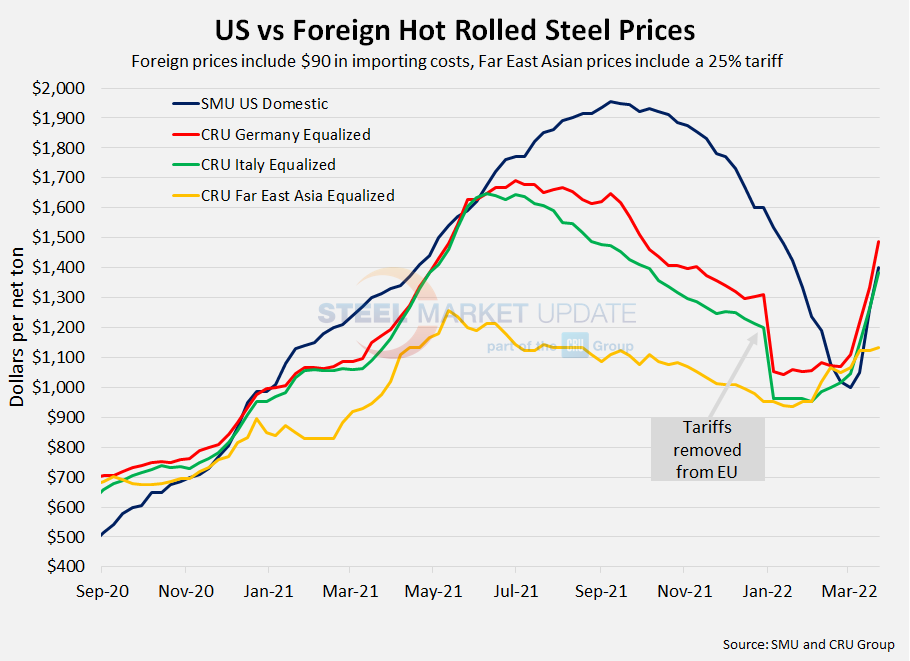
Note: Freight is an important part of the final determination on whether to import foreign steel or buy from a domestic mill supplier. Domestic prices are referenced as FOB the producing mill, while foreign prices are FOB the Port (Houston, NOLA, Savannah, Los Angeles, Camden, etc.). Inland freight, from either a domestic mill or from the port, can dramatically impact the competitiveness of both domestic and foreign steel. When considering lead times, a buyer must take into consideration the momentum of pricing both domestically and in the world markets. In most circumstances (but not all), domestic steel will deliver faster than foreign steel ordered on the same day.
By Brett Linton, Brett@SteelMarkeUpdate.com

Brett Linton
Read more from Brett LintonLatest in International Steel Prices

US and offshore HRC prices tick lower
The threat of tariffs over the past two months has been a springboard for US prices. But the Section 232 reinstatement on March 13 narrowed the domestic premium over imports on a landed basis.

Domestic CRC prices surge ahead of imports
The price spread between stateside-produced CR and imports reached its widest margin in over a year.

US HR prices rising faster than offshore tags
Hot-rolled (HR) coil prices continued to rally in the US this week, quickly outpacing price gains seen abroad. The result: US hot band prices have grown widely more expensive than imports on a landed basis. The premium US HR tags carry over HR prices abroad now stands at a 14-month high. SMU’s average domestic HR […]

US HR price premium over imports widens
Hot-rolled (HR) coil prices were flat in the US this week, while tags in offshore markets were mostly down.

US HR price premium over imports edges up
The price premium between stateside hot band and landed imports widened slightly this week.
